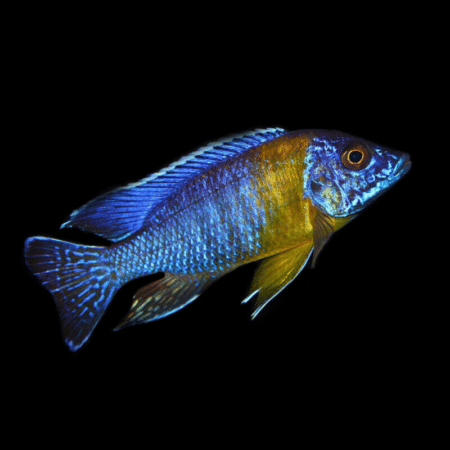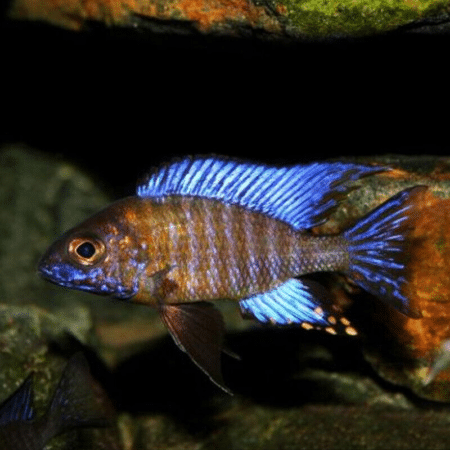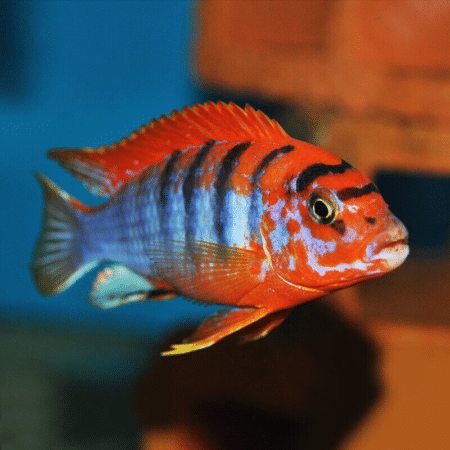Subtotal: £41.61
Aulonocara sp. calicoCalico Peacock Cichlid Lake Malawi Cichlid 4-5 Cm, Stunning Peaceful Companions for Community Aquariums – Easy Care and Beautiful Colors
£26.99 Original price was: £26.99.£22.58Current price is: £22.58.
Welcome these stunning Aulonocara sp. calico, beautiful Lake Malawi cichlids that thrive in community tanks. With their vibrant colors and peaceful temperament, they’re perfect for aquarists seeking graceful companions. Create a thriving aquarium setup with these elegant fish today.
Species Introduction
The Aulonocara sp. calico, commonly known as the Calico Peacock Cichlid, is a stunning member of the Cichlidae family, originating from the vibrant waters of Lake Malawi in East Africa. This species is renowned for its striking coloration, which features a blend of bright yellows, blues, and blacks, creating a visually captivating display in any freshwater aquarium. Typically, these fish reach a size of 4-5 cm, making them a perfect choice for both beginner and experienced aquarists looking to enhance their aquatic environment with lively and colorful inhabitants. In their natural habitat, they thrive among rocky substrates and sandy bottoms, where they can find ample hiding spots and territories to establish. Understanding their origins and natural behaviors is essential for providing a suitable home for these beautiful creatures.
Care Requirements Dashboard
| Optimal Living Conditions | |
|---|---|
| Water Temperature | 24-27°C (75-81°F) |
| pH Level | 6.5-7.5 |
| Water Hardness | 4-12 dKH |
| Minimum Tank Size | 80L (20 gal) |
| Salinity | Freshwater |
| Care Level | Beginner Friendly |
To ensure the optimal health and well-being of the Aulonocara sp. calico, it is crucial to maintain stable water parameters. This includes providing a tank size of at least 75 liters (20 gallons), as these fish appreciate space to swim and establish territories. The ideal water temperature ranges from 24 to 28 degrees Celsius (75-82 degrees Fahrenheit), with a pH level of 7.5 to 8.5, reflecting the alkaline conditions of their native habitat. Additionally, a water hardness of 10 to 20 dGH is recommended to mimic the natural environment of Lake Malawi. Regular water changes and monitoring are essential to maintain these parameters, ensuring a healthy and thriving aquatic community.
Natural Behavior & Temperament
The Aulonocara sp. calico exhibits a fascinating range of natural behaviors that are both captivating and informative for aquarists. These fish are known for their semi-aggressive temperament, especially during breeding seasons, where males may display territorial behaviors to attract females. However, they are generally considered peaceful cichlids, making them suitable for community tanks with other compatible species. In the wild, they are often found swimming in the mid to upper levels of the water column, foraging for food among rocks and plants. Providing ample hiding spots and territories within the aquarium setup is essential to reduce stress and encourage natural behaviors. Observing their interactions and social dynamics can be a rewarding experience, as they engage in playful displays and establish hierarchies within the tank.
Tank Setup Guide
Creating an ideal environment for your Aulonocara sp. calico involves careful consideration of tank setup and decorations. Start with a tank size of at least 75 liters (20 gallons) to provide ample swimming space. The substrate should consist of fine sand or small gravel, mimicking their natural habitat. Incorporating rocks, caves, and driftwood will not only enhance the aesthetic appeal but also offer hiding spots and territories for your fish friends. Live plants can also be added, but be cautious as some cichlids may uproot them. Ensure that the decorations are stable and secure to prevent any accidents. Additionally, a good filtration system is crucial to maintain water quality, as these fish thrive in clean, well-oxygenated water. Proper lighting will enhance the colors of the Calico Peacock Cichlid, making them a stunning focal point in your aquarium.
Water Quality Management
Maintaining optimal water quality is paramount for the health and longevity of the Aulonocara sp. calico. Regular testing of water parameters is essential to ensure that the pH level remains between 7.5 and 8.5, with a temperature range of 24 to 28 degrees Celsius (75-82 degrees Fahrenheit). The hardness should be maintained between 10 to 20 dGH. Utilizing a reliable water testing kit will help monitor these parameters accurately. Frequent water changes, approximately 20-30% weekly, will help remove toxins and replenish essential minerals. Additionally, consider using a high-quality filtration system to keep the water clean and well-circulated. It is also advisable to use a dechlorinator when adding tap water to the tank, as chlorine can be harmful to fish. By prioritizing water quality management, you will create a thriving environment for your Calico Peacock Cichlid.
Feeding & Nutrition
Diet: Omnivorous
Feeding Schedule: 2-3 times daily
Food Types: High-quality pellets, flakes, frozen or live foods
The Aulonocara sp. calico is an omnivorous species, thriving on a varied diet that includes high-quality pellets, flakes, and occasional treats of frozen or live foods such as brine shrimp and bloodworms. A balanced diet is essential for their health, coloration, and overall vitality. It is recommended to feed them 2-3 times daily, providing only what they can consume within a few minutes to avoid overfeeding and water quality issues. Incorporating a variety of food types will not only enhance their nutritional intake but also stimulate natural foraging behaviors. Observing their feeding habits can be quite entertaining, as they exhibit unique behaviors while hunting for food. Always ensure that the food is appropriate for their size and age, as this will promote healthy growth and development.
Compatibility Guide
When considering tank mates for your Aulonocara sp. calico, it is essential to select species that share similar water parameters and temperament. These cichlids generally coexist well with other peaceful species, making them suitable for community tanks. Ideal tank mates include other Lake Malawi cichlids, such as the Labidochromis caeruleus and Pseudotropheus species, as well as non-cichlid species like tetras and rasboras. However, it is crucial to avoid overly aggressive species that may stress or harm your Calico Peacock Cichlid. Additionally, providing ample hiding spots and territories will help minimize aggression and establish a harmonious environment. Always monitor interactions between different species, especially during the initial introduction phase, to ensure compatibility and reduce stress.
Health & Wellness
Maintaining the health and wellness of your Aulonocara sp. calico involves regular monitoring and preventive measures. Common health issues in cichlids include ich, fin rot, and swim bladder disease. Signs of illness may include changes in behavior, such as lethargy, loss of appetite, or abnormal swimming patterns. To prevent these issues, ensure that water quality is consistently maintained, and avoid overcrowding in the tank. Quarantine any new fish before introducing them to the main tank to prevent the spread of diseases. Additionally, providing a varied diet rich in vitamins and minerals will enhance their immune system and overall health. Regular observation and prompt action at the first signs of illness can significantly improve outcomes and ensure a thriving aquatic environment.
Breeding Information
Breeding Aulonocara sp. calico can be a rewarding experience for aquarists. These fish are mouthbrooders, meaning that the female carries the fertilized eggs in her mouth until they hatch. To encourage breeding, provide a separate breeding tank with plenty of hiding spots and suitable substrate. The ideal conditions for breeding include stable water parameters, a slightly higher temperature, and a well-balanced diet for both the male and female. Once the female has laid her eggs, she will collect them in her mouth for incubation, which typically lasts around 3 weeks. After hatching, the fry can be released into the main tank, where they will require finely crushed food or specialized fry food until they are large enough to eat standard pellets. Monitoring the breeding process can provide valuable insights into the reproductive behaviors of these beautiful cichlids.
Acclimation Process
Proper acclimation is crucial for the successful introduction of Aulonocara sp. calico into a new aquarium. When bringing home your new fish friends, it is essential to avoid sudden changes in water parameters, which can lead to stress and health issues. Begin by floating the sealed bag in the aquarium for about 15-20 minutes to equalize the temperature. After this, gradually introduce small amounts of tank water into the bag every 5-10 minutes, allowing the fish to acclimate to the new water chemistry. This process should take about an hour. Once acclimated, gently transfer the fish into the tank using a net, avoiding adding any bag water to the aquarium. This careful acclimation process will help ensure a smooth transition and promote the well-being of your Calico Peacock Cichlid.
Long-term Care
Long-term care of Aulonocara sp. calico involves consistent attention to their environment and health. These fish can live for several years when provided with optimal conditions, including stable water parameters, a balanced diet, and a well-maintained aquarium. Regular tank maintenance, including water changes and substrate cleaning, is essential to prevent the buildup of harmful toxins. Additionally, monitoring for signs of stress or illness will help catch any potential issues early. As they grow, you may need to adjust tank mates and provide more space to accommodate their territorial behaviors. Engaging with your fish friends through observation and interaction will enhance your experience as an aquarist and contribute to the overall health and happiness of your aquatic companions.
Natural Habitat Recreation
Recreating the natural habitat of the Aulonocara sp. calico in your aquarium will not only enhance their well-being but also provide a more aesthetically pleasing environment. In Lake Malawi, these fish inhabit rocky areas with sandy substrates, where they can find shelter and forage for food. To mimic this environment, use a combination of smooth rocks, caves, and sandy substrate in your aquarium setup. This will create hiding spots and territories for your fish, reducing stress and promoting natural behaviors. Additionally, consider incorporating live plants that are native to their habitat, as these will contribute to the overall biotope and enhance the visual appeal of your aquarium. By focusing on natural habitat recreation, you will create a thriving environment for your Calico Peacock Cichlid.
Seasonal Care Adjustments
As seasons change, it is essential to make necessary adjustments in the care of your Aulonocara sp. calico to ensure their continued health and well-being. During the warmer months, water temperatures may rise, necessitating closer monitoring to prevent overheating. Consider using fans or chillers to maintain stable temperatures within the ideal range. Conversely, in colder months, ensure that the aquarium heater is functioning correctly to maintain warmth. Additionally, lighting patterns may need adjustment to mimic natural daylight cycles, promoting healthy growth and behavior. Seasonal changes can also affect feeding habits, so be attentive to any changes in appetite or activity levels. By being proactive in seasonal care adjustments, you will provide a stable and nurturing environment for your aquatic companions.
Expert Tips
For those looking to enhance their experience with Aulonocara sp. calico, consider implementing some expert tips to elevate your aquarium setup and care routine. First, invest in high-quality filtration systems to maintain optimal water quality, as these fish thrive in clean environments. Additionally, consider using a substrate that mimics their natural habitat, such as fine sand, to encourage natural behaviors. Regularly observe your fish for signs of stress or illness, and be prepared to make adjustments as needed. Engaging with your fish friends through feeding and observation can deepen your appreciation for their beauty and behaviors. Lastly, consider joining local or online aquarist communities to share experiences and gain insights from fellow enthusiasts. By applying these expert tips, you will create a thriving environment for your Calico Peacock Cichlid.
Troubleshooting
Even with the best care, issues may arise when keeping Aulonocara sp. calico. Common problems include aggression among tank mates, poor water quality, and health issues. If you notice signs of aggression, such as fin nipping or territorial disputes, consider rearranging the tank to disrupt established territories or adding more hiding spots. For water quality issues, regularly test parameters and perform water changes as needed. If health issues arise, such as lethargy or loss of appetite, assess water quality and diet, and consult with a veterinarian specializing in fish care if necessary. Being proactive and attentive to your aquarium will help you troubleshoot common problems and maintain a healthy environment for your aquatic companions.
Scientific Background
The Aulonocara sp. calico belongs to the Cichlidae family, which is known for its remarkable diversity and adaptability in freshwater environments. This species, like many other Lake Malawi cichlids, has evolved unique characteristics that allow it to thrive in specific ecological niches within the lake. Research into the behaviors, breeding patterns, and ecological roles of cichlids continues to provide valuable insights into their biology and conservation. Understanding the scientific background of your fish friends can enhance your appreciation for their complexity and the importance of preserving their natural habitats. As an aquarist, you play a vital role in contributing to the knowledge and conservation of these beautiful creatures.
Advanced Care Techniques
For experienced aquarists looking to take their care of Aulonocara sp. calico to the next level, consider implementing advanced techniques that promote optimal health and well-being. This includes regular monitoring of water parameters and adjusting filtration systems to ensure maximum efficiency. Additionally, consider utilizing a breeding setup to encourage natural spawning behaviors, which can lead to healthier fry. Experiment with different diets, incorporating high-quality live foods to enhance coloration and vitality. Engaging in regular observation and behavioral studies can deepen your understanding of their needs and preferences. By applying these advanced care techniques, you will create an enriching environment that fosters the beauty and health of your Calico Peacock Cichlid.
Frequently Asked Questions
Q: What tank size is required for the Aulonocara sp. calico?
The Aulonocara sp. calico, also known as the Calico Peacock Cichlid, requires a tank of at least 150 litres to thrive. This ensures ample swimming space and helps maintain stable water parameters. A larger tank is preferable, especially if you plan to keep multiple individuals, as they can display territorial behaviour. It’s crucial to include hiding spots and open swimming areas to mimic their natural habitat. Additionally, a well-maintained filtration system is essential to keep the water clean and oxygenated.
✓ Expert Tip
Consider adding rocks and caves in the aquarium to create territories, which can help reduce aggression among males.
Q: What water parameters do Aulonocara sp. calico require?
Aulonocara sp. calico thrive in slightly alkaline to neutral water with a pH range of 7.5 to 8.5. They prefer a water temperature between 24°C to 28°C. Regular water changes of around 15-20% weekly are recommended to maintain optimal water quality. It is essential to monitor hardness levels, ideally between 10-20 dGH, as they are accustomed to the mineral-rich waters of Lake Malawi. Utilising a good-quality water conditioner can help in achieving these parameters.
✓ Expert Tip
Regularly test your water parameters with a reliable test kit to ensure a stable environment for your fish friends.
Q: How often should I feed the Aulonocara sp. calico?
Feed your Aulonocara sp. calico twice a day, providing only what they can consume in a few minutes. A varied diet is crucial; offer high-quality cichlid pellets, frozen or live foods such as brine shrimp and daphnia, and occasional vegetable matter like spirulina flakes. Overfeeding can lead to poor water quality and health issues, so it’s essential to be mindful of their intake. Monitor their behaviour to ensure they are eating well and adjust portions as necessary.
✓ Expert Tip
Incorporate a variety of foods to enhance colouration and overall health.
Q: What are the best tank mates for Aulonocara sp. calico?
Aulonocara sp. calico are generally peaceful but can be territorial, especially males. Compatible tank mates include other Malawi cichlids, such as Mbunas or other Aulonocara species, provided the tank is spacious enough. Avoid aggressive species, as they may stress your calico. Community fish such as catfish or certain tetras may also work, but ensure they can coexist without competing for territory. It’s best to introduce tank mates simultaneously to reduce territorial disputes.
✓ Expert Tip
Observe interactions closely when introducing new tank mates to ensure harmony.
Q: How do I properly acclimatise Aulonocara sp. calico to my aquarium?
Acclimatisation is crucial for reducing stress in your new Aulonocara sp. calico. Begin by floating the sealed bag in your aquarium for about 15-20 minutes to equalise the temperature. Then, gradually introduce small amounts of aquarium water into the bag every 10 minutes for an hour. This process helps the fish adapt to the new water parameters. After an hour, gently transfer the fish into the tank using a net, discarding the water from the bag to avoid introducing any potential contaminants.
✓ Expert Tip
Always acclimatise fish slowly to avoid shock, which can lead to health issues.
Q: What are the signs of healthy Aulonocara sp. calico?
Healthy Aulonocara sp. calico exhibit vibrant colours, clear eyes, and active behaviour. They should swim confidently throughout the tank, showing curiosity towards their environment. Look for signs of stress or illness, such as lethargy, faded colours, or abnormal swimming patterns. Healthy fish will also display a good appetite and interact with their tank mates. Regular monitoring of their behaviour and appearance can help you catch any health issues early.
✓ Expert Tip
Maintain a stress-free environment to promote overall health and well-being.
Q: How do I successfully breed Aulonocara sp. calico?
Breeding Aulonocara sp. calico can be rewarding. Start by ensuring a stable environment with optimal water conditions. Males will display vibrant colours to attract females, and once a pair forms, the female will lay eggs in a flat substrate area. Provide a breeding cave or flat rock for egg-laying. After fertilisation, the female will mouthbrood the eggs until they hatch. It’s essential to separate the male after breeding to prevent aggression and stress on the female and fry.
✓ Expert Tip
Consider setting up a separate breeding tank to increase fry survival rates.
Q: What temperature should I maintain for Aulonocara sp. calico?
Aulonocara sp. calico thrive in a temperature range of 24°C to 28°C. Maintaining a consistent temperature is crucial for their health, as fluctuations can lead to stress and disease. Use an aquarium heater with a reliable thermostat to achieve and maintain this temperature range. Regularly check the temperature with a thermometer, and position it away from direct heat sources to ensure accurate readings.
✓ Expert Tip
Consider using a heater guard to prevent burns and ensure safety.
Q: How long do Aulonocara sp. calico typically live in captivity?
With proper care, Aulonocara sp. calico can live for 8 to 10 years in captivity. Their lifespan can be influenced by factors such as tank conditions, diet, and overall health management. Regular water changes, a balanced diet, and monitoring for diseases are essential components of their care. Providing a stress-free environment and suitable tank mates will also contribute to their longevity.
✓ Expert Tip
Keep a consistent care routine to maximise their life expectancy.
Q: What type of substrate is most suitable for Aulonocara sp. calico?
Aulonocara sp. calico prefer a sandy substrate, which mimics their natural habitat in Lake Malawi. A fine sand allows them to dig and sift through it, promoting natural behaviour. Avoid sharp-edged substrates, as they can injure your fish. A depth of around 2-3 inches is ideal, allowing them to create hiding spots. You can also incorporate smooth stones or rocks to enhance the aesthetic appeal and provide additional shelter.
✓ Expert Tip
Ensure the substrate is clean before adding it to the tank to prevent cloudiness.
Q: What behavioural patterns should I expect from Aulonocara sp. calico?
Aulonocara sp. calico exhibit a variety of behaviours, including territorial displays, especially among males. They are generally peaceful but may show aggression during breeding or when establishing territories. These fish are social and enjoy the company of their own kind, often forming small groups. They are also known for their vibrant displays and interactions, such as chasing each other or darting in and out of hiding spots. Observing their behaviour can be a rewarding aspect of fish-keeping.
✓ Expert Tip
Provide plenty of hiding spots to help reduce aggression and promote natural behaviours.
Q: How can I prevent common diseases in Aulonocara sp. calico?
Preventing diseases in Aulonocara sp. calico involves maintaining excellent water quality and a stable environment. Regular water changes, proper filtration, and avoiding overfeeding are essential practices. Quarantine any new fish before introducing them to the main tank to avoid introducing pathogens. Additionally, providing a varied diet rich in vitamins can boost their immune system. Observe your fish regularly for any signs of stress or illness, and act quickly if you notice any changes in behaviour or appearance.
✓ Expert Tip
Maintain a stress-free environment by avoiding overcrowding and aggressive tank mates.
Q: What lighting conditions do Aulonocara sp. calico prefer?
Aulonocara sp. calico thrive under moderate lighting conditions that mimic their natural environment. A combination of ambient and direct lighting can showcase their vibrant colours beautifully. LED lighting is often recommended due to its energy efficiency and adjustable settings. Ensure that the lighting is not too intense, as overly bright conditions can cause stress. Providing shaded areas with decorations or plants can also help create a comfortable environment.
✓ Expert Tip
Consider a lighting schedule of 10-12 hours a day to mimic natural daylight cycles.
Q: How do I recognise stress in Aulonocara sp. calico?
Signs of stress in Aulonocara sp. calico can include hiding excessively, erratic swimming patterns, and loss of colour vibrancy. If they are constantly darting around or staying at the bottom of the tank, it may indicate stress. Additionally, a lack of appetite or aggression towards tank mates can also be signs. Regular observation of your fish will help you notice these behaviours early, allowing for timely intervention to address any issues.
✓ Expert Tip
Always strive to maintain a peaceful and stable environment to minimise stress factors.
Q: What natural habitat conditions should I replicate for Aulonocara sp. calico?
To replicate the natural habitat of Aulonocara sp. calico, aim for a setup that mimics the rocky and sandy environments of Lake Malawi. Incorporate smooth rocks, caves, and sandy substrate for digging. Maintaining stable water parameters, including pH and temperature, is crucial. Additionally, providing adequate filtration and aeration will ensure a clean and healthy environment. Regularly monitor the water quality to keep these beautiful creatures thriving.
✓ Expert Tip
Research the natural habitats of Malawi cichlids to create a more authentic environment.











